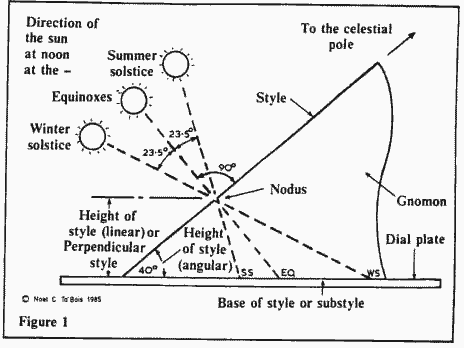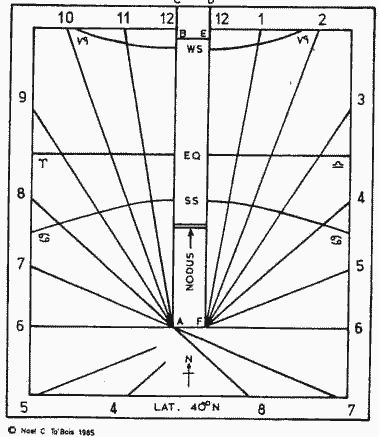This is one of a series of articles written for "Clocks" magazine by the
late Noel Ta'bois, and reproduced with permission here as a memorial
to him.
This article originally appeared in Clocks in February 1985
This month I discuss the subtle difference in meaning between gnomon and style, with some diversions on the way for good measure. Dictionary definitions indicate that the two words are synonymous and they are often treated as such with no confusion. However, contention now advises that gnomon should be used for the physical structure and style for the geometrical point or edge which casts the shadow.
 Figure 1 shows a side view of the essential parts of a horizontal sundial, for a latitude of 40 degrees as it happens but the principles are the same for any latitude. The style is the sloping edge of the gnomon. The base of the style or substyle is the attachment of the gnomon to the dial plate, and the perpendicular style is the height of the nodus. Style, not gnomon, is always used in these contexts. The perpendicular style is sometimes known as the height of the style. I used to get very confused by this term until I realised that it can also refer to the angular measurement.
Figure 1 shows a side view of the essential parts of a horizontal sundial, for a latitude of 40 degrees as it happens but the principles are the same for any latitude. The style is the sloping edge of the gnomon. The base of the style or substyle is the attachment of the gnomon to the dial plate, and the perpendicular style is the height of the nodus. Style, not gnomon, is always used in these contexts. The perpendicular style is sometimes known as the height of the style. I used to get very confused by this term until I realised that it can also refer to the angular measurement.
The gnomon of figure 1 is a physical structure and must therefore have some thickness. This is shown (exaggerated for clarity) in figure 2 which is a plan view of the sundial of figure 1, the rectangle ABEF being the sloping edge of the gnomon seen from above. Because this edge lies parallel to the earth's axis the sun is in effect circling it once every 24 hours, at right angle sat the equinoxes and at angles up to 231/2 degrees at the solstices. These movements of the sun cause the moving shadow of the nodus to follow the declination lines on the dial plate. Unfortunately there is not sufficient space here to discuss this in detail.
 From midnight to noon the sun is on the right of the gnomon, and from noon to midnight on the left, the transitions from one side to the other being made at noon and midnight. At midnight the sun is below the horizon. Because the plane ABEF is at right angles to the gnomon, by similar reasoning, the sun spends 12 hours above this plane from 6am to 6pm, and 12 hours below it from 6pm to 6am, the transitions being made at six o'clock morning and evening. These four transitions cause the two edges of the gnomon which cast the shadow to alternate every six hours. From midnight to noon the sun is on the right of the gnomon, and from noon to midnight on the left, the transitions from one side to the other being made at noon and midnight. At midnight the sun is below the horizon. Because the plane ABEF is at right angles to the gnomon, by similar reasoning, the sun spends 12 hours above this plane from 6am to 6pm, and 12 hours below it from 6pm to 6am, the transitions being made at six o'clock morning and evening. These four transitions cause the two edges of the gnomon which cast the shadow to alternate every six hours.
From sunrise to 6am local solar time, the position of the sun is such that the edge FE casts the shadow and this therefore is the style. From 6am to noon AB becomes he style. at noon the sun lies due south and the gnomon casts a shadow covering the area BCDE. Points C and D both indicate 12 o'clock. From noon, as the sun moves west, FE becomes the style again until 6pm when it reverts once more to AB until sunset.
At 6 o'clock every morning and evening throughout the year the sun lies on the plane of ABEF, but its position in the sky varies with the season. At the equinoxes the sun lies due east and west on the horizon. During the summer months in the northern hemisphere the sun is above the horizon to the north of east or west, while during the winter months it is south of east or west and below the horizon. Don't forget the sun when it is hidden by the earth; keep its position in mind at all times. This will help you when you come to study times of sunrise and sunset.
|  For
a full overview click
here
For
a full overview click
here  For
a full overview click
here
For
a full overview click
here